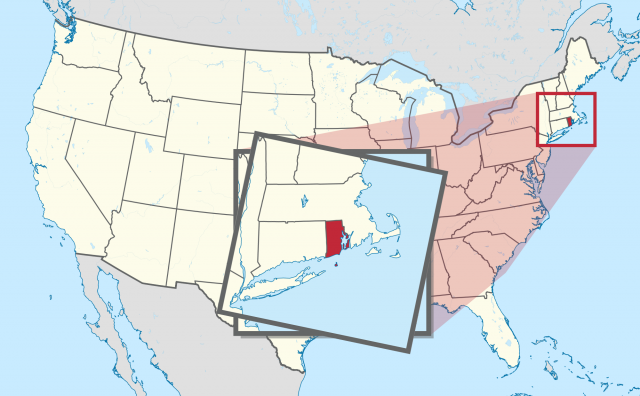Rhode Island
RHODE ISLAND, SMALLEST of the 50 United States at 1,214 square mi (3,144 square km), is located in New England on the ATLANTIC seaboard. It is bounded by MASSACHUSETTS on the north and east, the Atlantic Ocean to the south, and CONNECTICUT in the west. While it is typically referred to as Rhode Island, the official name is actually the State of Rhode Island and Providence Plantations. Interestingly, nearly one-third of the state's total area, 500 square mi (1,295 square km), is water.
In 2000, the state had a populatioN of 1,048,319, an increase of 4.5 percent since the last census in 1990. Although more than half of Rhode Island is covered with forests, it is highly urbanized. Providence is the capital and the largest city; other important cities are Warwick, Cranston, Pawtucket, and Newport. Though the population numbers may not seem big, when coupled with the state's small area, Rhode Island is the second most densely populated state with 864 people per square mi (2,238 per square km). Rhode Island was the 13th of the original 13 colonies to ratify the Constitution. It became a state on May 29, 1790.

Most of the state in the south and east can be described as part of the Coastal Lowland Region while the lands in the northwest are part of the Eastern New England Upland. The highest point is Jerimoth Hill at 812 ft (248 m) above sea level. The dominant physiographic feature of the state is the Narragansett basin, a shallow lowland area of carboniferous sediments that extends southeastward into Massachusetts.
In Rhode Island, the sediments are partly submerged as Narragansett Bay, which cuts inland for about 30 mi (50 km) to Providence. The bay contains several interesting islands, including Rhode Island (or Aquidneck), the largest and the site of historic Newport, Conanicut Island with the Jamestown Resort, and Prudence Island. Numerous sand spits and barrier beaches, in addition to small sheltering lagoons and salt marshes, mark the coastline. The general countryside contains many small lakes and a rolling hilly surface that is punctuated by short, swift streams and numerous waterfalls, all remnant of the last glaciation.
The Massachusetts Bay colony established the first settlement in the area at Providence on land purchased from Native Americans in 1636. In 1638, Puritan exiles bought the island of Aquidneck (now Rhode Island) from the Narragansetts established the settlement of Portsmouth (1638). In order to thwart claims made to the area by rivaling colonies (Massachusetts Bay and Plymouth), Roger Williams secured a parliamentary patent in 1644 and by 1647 had organized a government.
The early settlers were mostly English, with many drawn to the colony by the guarantee of religious freedom. The early settlers were allowed to own land that was bought from the Native Americans. Fishing and trade flourished in addition to a sound livestock industry and the more traditional agricultural products. Until the American Revolution, Newport was the commercial center of the colony, thriving on the triangular trade in rum, slaves, and molasses.
Rhode Island's traditional manufacturing economy has diversified to include important services, trade (retail and wholesale), and finance sectors. In addition, many of the traditional Rhode Island products (jewelry, silverware, textiles, primary and fabricated metals, machinery, electrical equipment, and rubber and plastic) are still being manufactured. While recent events have seen a growth in tourism agriculture has become relatively unimportant. The coastal areas are lined with resorts for swimming and boating, and windswept Block Island is a favorite vacation spot. Narragansett Bay remains famous for its sailing and yachting events, including the America's Cup yacht race that has been held in Newport several times, beginning in 1930 and most recently in 1983.
Most of the state's farmland is now used for dairy and poultry production, with Rhode Island Reds a nationally recognized brand of chickens. Commercial fishing remains important, but the industry is on the decline. U.S. naval facilities at Newport also contribute to the state's income.